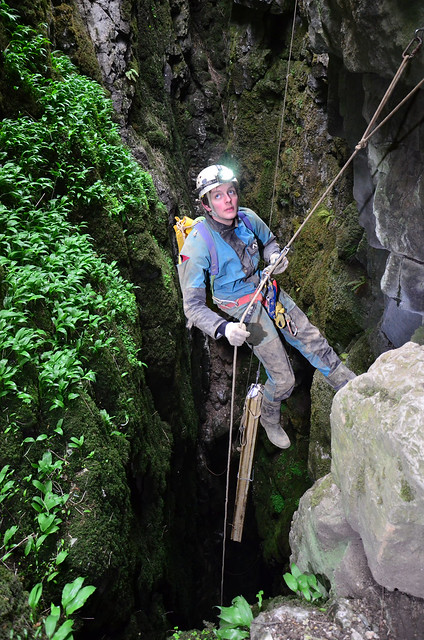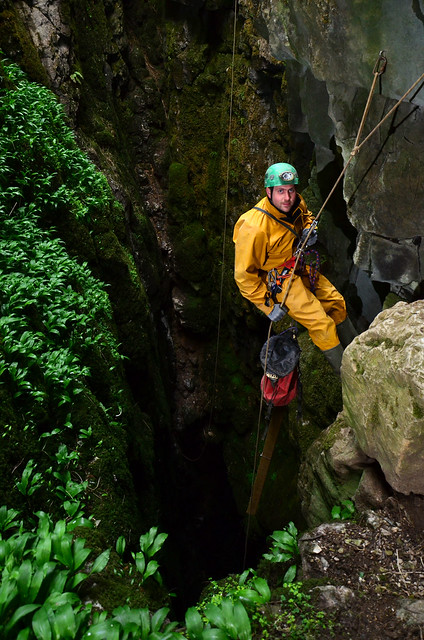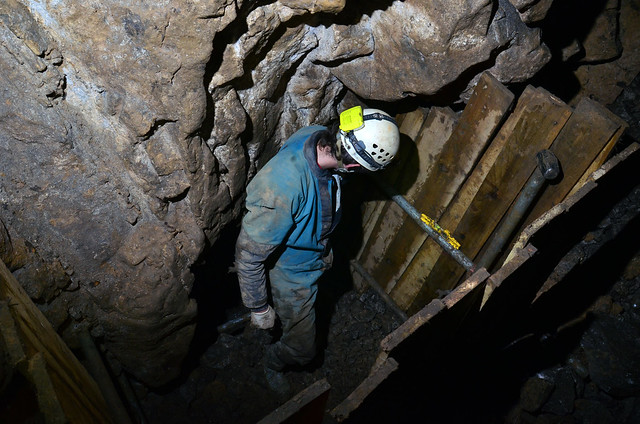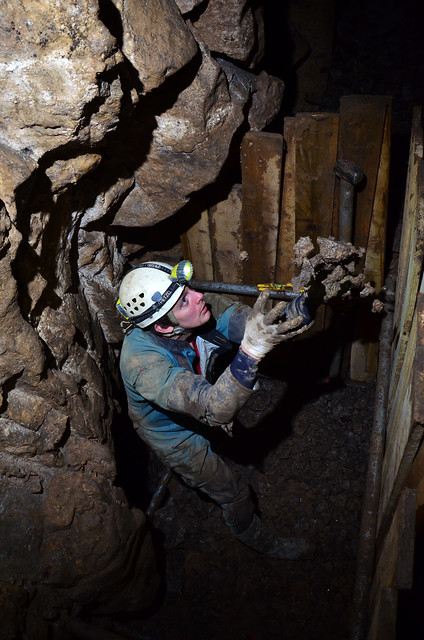You are using an out of date browser. It may not display this or other websites correctly.
You should upgrade or use an alternative browser.
You should upgrade or use an alternative browser.
Eldon Hole - Trip Report
- Thread starter Mark Wright
- Start date
alastairgott
Well-known member
shotlighter said:Cheeky swine :tease:alastairgott said:Aye, then again, i'm sure there was a photo in descent with a wall in when the original posts were put in by the old boys from crewe like shotlighter.
EDIT mind you it could have been worse, at least you didn't include "decrepit" as well as "old" in your description!
AR
Well-known member
pwhole said:Don't forget there's meant to be a dead guy and his horse buried down there somewhere too - thrown down by a highwayman after he robbed him, apparently. I don't know for certain what arrangements for access existed in the 18th and early 19th Centuries, but I'm guessing that if you weren't the farmer or a lead miner on one of the nearby veins, you probably shouldn't have been up there at all. I've often wondered how many 'tourists' actually tramped the plateau back in 1770. Can't have been that many.
Prior to enclosure, it was open common and anyone could wander at will on there but before the 19th century, tourists round there would have been an unusual occurrence.This was partly due to few having both the disposable income and the desire to visit what was generally considered "a howling wilderness" and partly due to the very real problem of footpads, who had no qualms about killing you for quite trivial sums - see Roger Flindall's "Mines, Quarries and Murders", which mentions cases where it was suspected people had been murdered by footpads and their corpses thrown into Eldon Hole. Given the presence of prehistoric enclosures nearby, I wouldn't be at all surprised if throwing people into the hole has very ancient roots,,,,
Like Graham, I think it's likely there would have been a wall or some kind of fence round the hole prior to enclosure, which would have needed occasional repair, and stone for it would have been taken from mine hillocks in the area. Significant attritional losses to the wall by visitors throwing stones into the hole is probably something fairly modern, as visitor numbers into the Peak gew over the last century.
graham
New member
OK
This is the point at which the diggers shout at me & tell me to p*** off and mind my own business.
I would hope that, as the shaft descends, some sort of section through the infill becomes visible. It would be very interesting in the light of several of the comments above, if that section could be either recorded as work progresses (best) or at least preserved for later study. I know it's asking a lot but it would be really nice for old farts such as me to be given an idea as to just how the fill did form.
This is the point at which the diggers shout at me & tell me to p*** off and mind my own business.
I would hope that, as the shaft descends, some sort of section through the infill becomes visible. It would be very interesting in the light of several of the comments above, if that section could be either recorded as work progresses (best) or at least preserved for later study. I know it's asking a lot but it would be really nice for old farts such as me to be given an idea as to just how the fill did form.
Mark R
Well-known member
Tom's latest Trip report here... http://www.butteredbadger.com/index.php?option=com_content&view=article&id=337 opping-a-ring&catid=45:eldon-dig-reports&Itemid=58
opping-a-ring&catid=45:eldon-dig-reports&Itemid=58
Madness
New member
Mark R said:It's going to take a while before we are even through the layer of modern fill and rubbish.. Still pulling out batteries, plastic and bits of metal. Lots of bones too.
If you find any human bones, you might get some digging help from Derbyshire Constabulary.
Mark Wright
Active member
Lloyds report posted by danthecavingman was our primary document when contemplating taking on the project.
In Fig. 111 of the report Lloyd mentions the height of the arch that leads into the Main Chamber at 'B' as being +/- 3 yards. Some of the measurements he gives of the Main Chamber are a little over exaggerated, but when all you have is a candle you might expect this. The +/- 3 yards though, you would think as being fairly accurate and easily within view. Today, the arch is less than a yard. The depth of the main shaft should have been easy to measure fairly accurately.
When members of the Eldon dug down in the area approx. 2 yards upslope of 'T', near the bottom of the Main Chamber, they hit a solid floor at +/- 8' suggesting that approx. 8' of additional rock has been thrown in (or otherwise deposited) since Lloyds visit. We removed a fair number of sizeable tree branches from about 5' depth in the very small area we were digging on Sunday so over the whole area of the bottom of the Main Chamber this could possibly account for some of the volume.
The report suggests that it was not too many years before Lloyds visit that the elusive second shaft was actually descended for some vast depth before reaching water.
It could well be that there isn't the vast amount of rock as Lloyd suggests in Fig 111 at all, he probably assumed it had a flat floor whereas the reports of descending the second shaft talk about steep ledges leading into it. In the area around the dig site, there might actually only be about 10' of rock to clear out before you find the old oak timbers that the miners most likely placed around the much narrower descending second shaft. If they actually did?
The bottom of the shaft we are currently digging (see MarkR's BBPC link with photographs) should be below this point within only a few weeks.
I am though, forever the optimist.
I do think, for the sake of consistency with Lloyds reporting, we should use imperial units in our reports. That'll confuse the therionists.
Mark
In Fig. 111 of the report Lloyd mentions the height of the arch that leads into the Main Chamber at 'B' as being +/- 3 yards. Some of the measurements he gives of the Main Chamber are a little over exaggerated, but when all you have is a candle you might expect this. The +/- 3 yards though, you would think as being fairly accurate and easily within view. Today, the arch is less than a yard. The depth of the main shaft should have been easy to measure fairly accurately.
When members of the Eldon dug down in the area approx. 2 yards upslope of 'T', near the bottom of the Main Chamber, they hit a solid floor at +/- 8' suggesting that approx. 8' of additional rock has been thrown in (or otherwise deposited) since Lloyds visit. We removed a fair number of sizeable tree branches from about 5' depth in the very small area we were digging on Sunday so over the whole area of the bottom of the Main Chamber this could possibly account for some of the volume.
The report suggests that it was not too many years before Lloyds visit that the elusive second shaft was actually descended for some vast depth before reaching water.
It could well be that there isn't the vast amount of rock as Lloyd suggests in Fig 111 at all, he probably assumed it had a flat floor whereas the reports of descending the second shaft talk about steep ledges leading into it. In the area around the dig site, there might actually only be about 10' of rock to clear out before you find the old oak timbers that the miners most likely placed around the much narrower descending second shaft. If they actually did?
The bottom of the shaft we are currently digging (see MarkR's BBPC link with photographs) should be below this point within only a few weeks.
I am though, forever the optimist.
I do think, for the sake of consistency with Lloyds reporting, we should use imperial units in our reports. That'll confuse the therionists.
Mark
cavermark
New member
Frost shattering off the walls is the only current process for a creating rock debris in a shaft (without a stream) that I can think of. I doubt it would have produced that amount of rock in 200 years. I suppose a big slump of material from further up could have occurred (held back by an old ice plug that then melted?) but that seems unlikely. Looking at the size of scree around the base of limestone crags I'd expect smaller sized lumps than the average walling stone.
The account seems accurate in most ways so maybe the bit about material being dumped in is also accurate. I agree that it seems odd that anyone would want to go to the trouble of filling the shaft in though (superstition? stop the devil escaping?)
The account seems accurate in most ways so maybe the bit about material being dumped in is also accurate. I agree that it seems odd that anyone would want to go to the trouble of filling the shaft in though (superstition? stop the devil escaping?)
graham
New member
Mark Wright said:I do think, for the sake of consistency with Lloyds reporting, we should use imperial units in our reports. That'll confuse the therionists.
Sorry, but Therion - and indeed Survex - can cope with any mix of units that you can throw at it, even if you change them from one leg to the next. 8)
TomTom
New member
I was asked for some pic's of the mildly posing team so prepare to scroll.......
Mark always caves with wood between his legs

and never looks where he's going

Chris seems more relaxed with the wood issue

and what started as a bank that wouldn't stay still

soon turned into something more reassuring

The housework needs to be kept up to date

But it's looking like a pretty good start

Mark always caves with wood between his legs

and never looks where he's going

Chris seems more relaxed with the wood issue

and what started as a bank that wouldn't stay still

soon turned into something more reassuring

The housework needs to be kept up to date

But it's looking like a pretty good start

Mark Wright
Active member
graham said:Mark Wright said:I do think, for the sake of consistency with Lloyds reporting, we should use imperial units in our reports. That'll confuse the therionists.
Sorry, but Therion - and indeed Survex - can cope with any mix of units that you can throw at it, even if you change them from one leg to the next. 8)
I wasn't thinking of the programs, I was thinking all those who aren't old enough to know what yards, feet and inches are.
graham said:OK
This is the point at which the diggers shout at me & tell me to p*** off and mind my own business.
I would hope that, as the shaft descends, some sort of section through the infill becomes visible. It would be very interesting in the light of several of the comments above, if that section could be either recorded as work progresses (best) or at least preserved for later study. I know it's asking a lot but it would be really nice for old farts such as me to be given an idea as to just how the fill did form.
We have been keeping a good photographic record of the dig to date, something we regretted we didn't do very well during the Rowter Hole dig so don't worry Graham I won't tell you to p*** off, we will try and keep as good a record as possible within the constraints of the shaft as it progresses.
We are back in there tomorrow so I will let you know how we get on.
Markl
graham
New member
Mark Wright said:I wasn't thinking of the programs, I was thinking all those who aren't old enough to know what yards, feet and inches are.
Another topic, methinks. But I can say that UBSS Proceedings 'went metric' in about 1968 yet certain other Mendip club publications did not do so until very, very recently.
Mark Wright said:We have been keeping a good photographic record of the dig to date, something we regretted we didn't do very well during the Rowter Hole dig so don't worry Graham I won't tell you to p*** off, we will try and keep as good a record as possible within the constraints of the shaft as it progresses.
We are back in there tomorrow so I will let you know how we get on.
Markl
Thanks, much appreciated.
Mark Wright
Active member
With Paz Vale, Sam Pemberton and Bob Toogood of the EPC we had an excellent days digging today. We once again pulled out a lot of rock and all the boards shown in the photographs posted by TomTom have been lowered to just above shaft top level and the dig is ready for the next scaffold ring to be installed at the bottom of the shaft on Thursday. A pulley has been installed above the shaft and ready for Tuesdays trip to haul some more rock.
Mark
Mark
SamT
Moderator
Bit of a write up on progress here...
http://www.eldonpotholeclub.org.uk/index.php/homepage/current-uk-projects/eldon-hole/250-a-ton-of-rock
http://www.eldonpotholeclub.org.uk/index.php/homepage/current-uk-projects/eldon-hole/250-a-ton-of-rock
Mark Wright
Active member
With 4 diggers crying off tonight (Thursday) it left Mark Richardson, TomTom, Henry Rockliff and me to make 2 trips over to the entrance with 32 x 1.8m boards. Mark had left them out in the rain the previous night so they were quite heavy.
Once we had double Stopped our heavy loads down the shaft and manipulated them through the rather miserable squirm that leads to the Main Chamber we set about getting the next ring into position.
Due to the shape of the walls in the next section of passage there would need to be some very complicated bracing required to make the structure stable so we decided to step the shaft in a bit and continue as a triangular shaft. This will ensure we get the stainless pins that support the ends of the scaffold tubes at the right angle to provide most strength. Its also a lot cheeper to build a two sided shaft than a 3 sided one. We may well decide to step it down again in another 1.8m.
We installed the first 2 triangular rings and got all the boards in place ready for Sundays trip where we should be able to drop the shaft to -3.6m.
I think it was about 7pm when we set off down and it was warm and sunny. When peering over the handrail at the dig site, with nobody actually in the dig, I could definitely feel a cool draught on my face. At around 9.30pm I stuck my head through the awkward (currently) squeeze a little lower down and could feel no draught at all. When I was digging out rocks from the base of the shaft I'm sure I had a cool feeling on my face?
The section through the shaft is much the same as before but there have been more larger rocks coming out at this level. No horses or their riders yet.
Keep an eye out for Sundays trip report.
Mark
Once we had double Stopped our heavy loads down the shaft and manipulated them through the rather miserable squirm that leads to the Main Chamber we set about getting the next ring into position.
Due to the shape of the walls in the next section of passage there would need to be some very complicated bracing required to make the structure stable so we decided to step the shaft in a bit and continue as a triangular shaft. This will ensure we get the stainless pins that support the ends of the scaffold tubes at the right angle to provide most strength. Its also a lot cheeper to build a two sided shaft than a 3 sided one. We may well decide to step it down again in another 1.8m.
We installed the first 2 triangular rings and got all the boards in place ready for Sundays trip where we should be able to drop the shaft to -3.6m.
I think it was about 7pm when we set off down and it was warm and sunny. When peering over the handrail at the dig site, with nobody actually in the dig, I could definitely feel a cool draught on my face. At around 9.30pm I stuck my head through the awkward (currently) squeeze a little lower down and could feel no draught at all. When I was digging out rocks from the base of the shaft I'm sure I had a cool feeling on my face?
The section through the shaft is much the same as before but there have been more larger rocks coming out at this level. No horses or their riders yet.
Keep an eye out for Sundays trip report.
Mark



